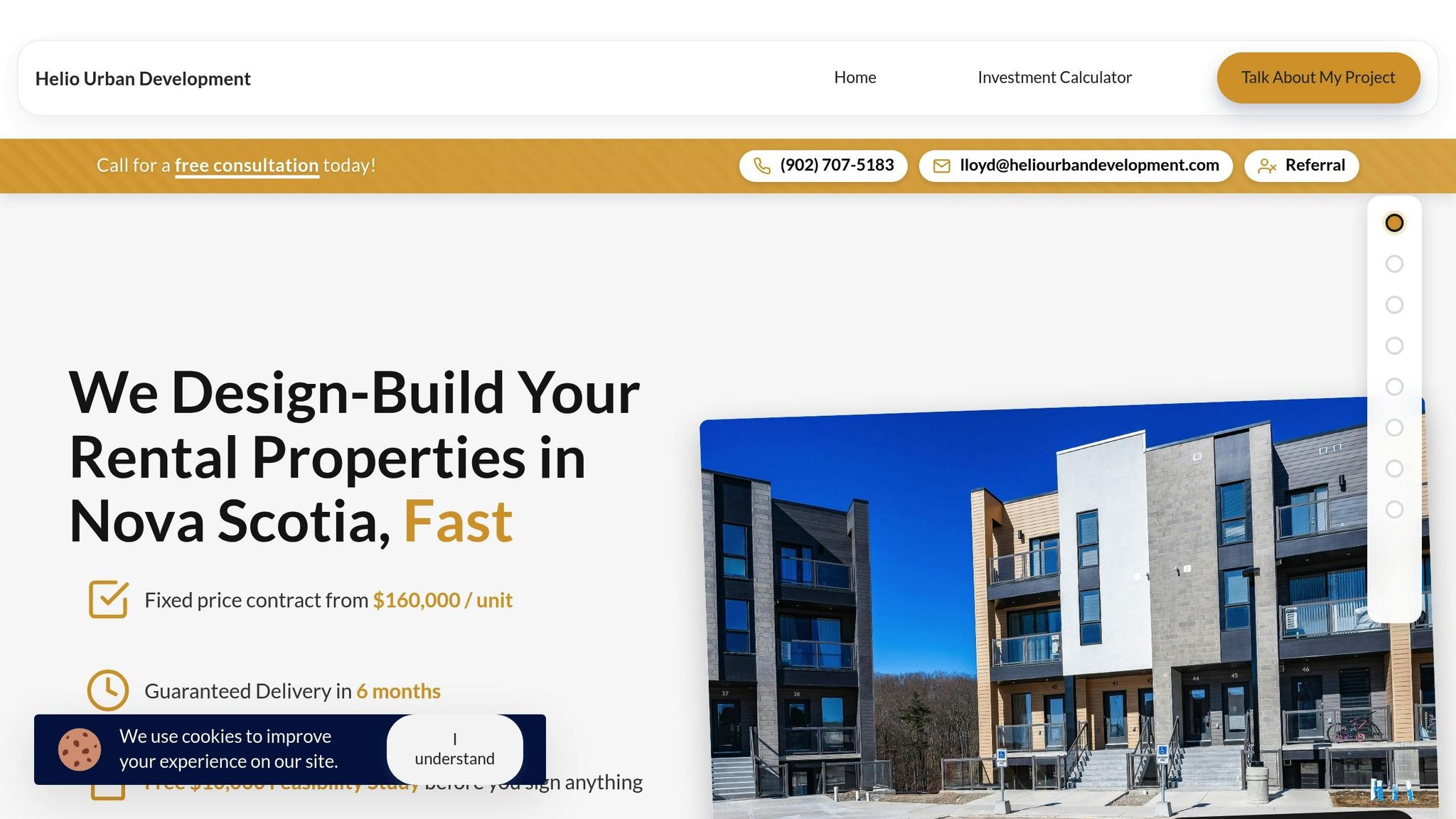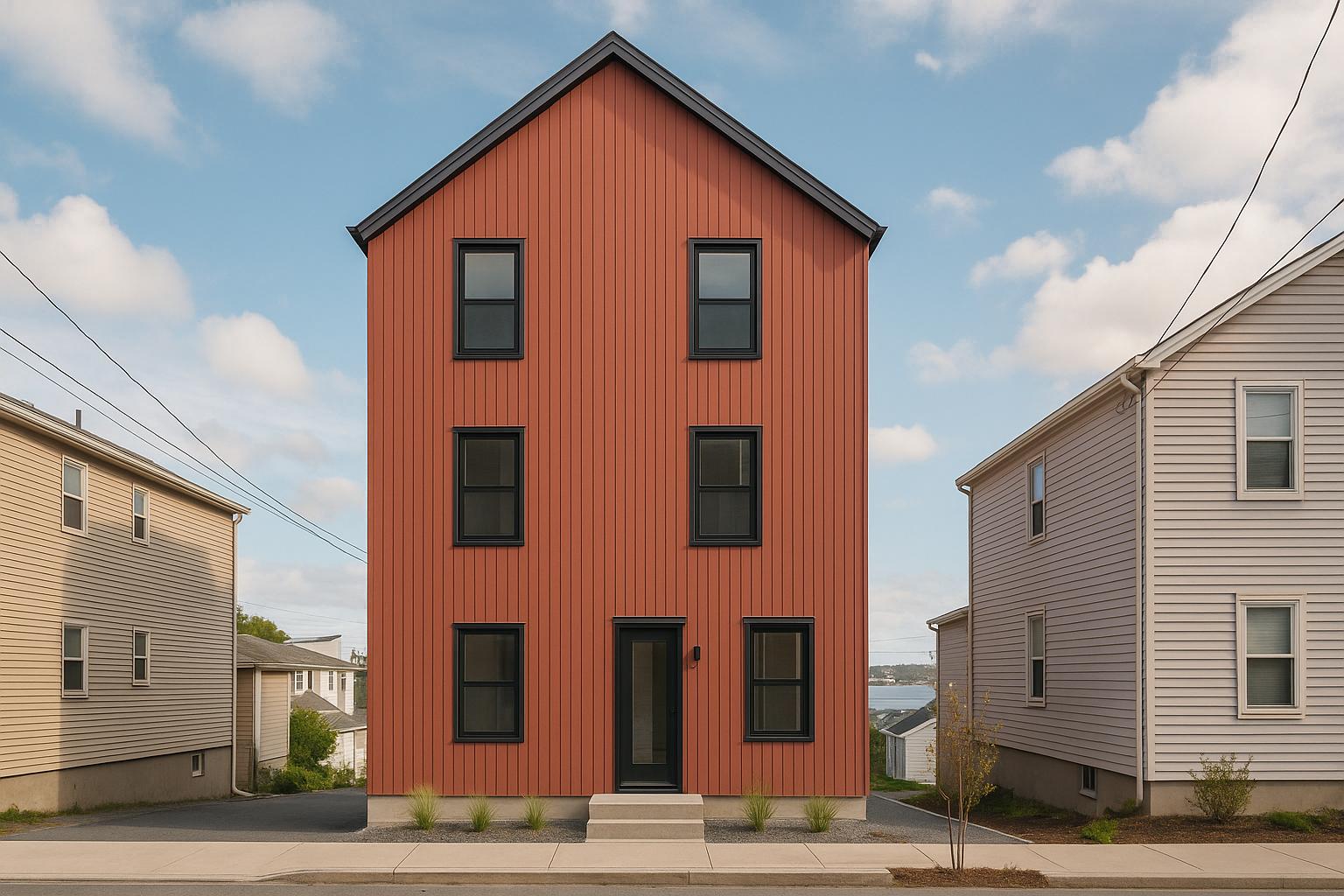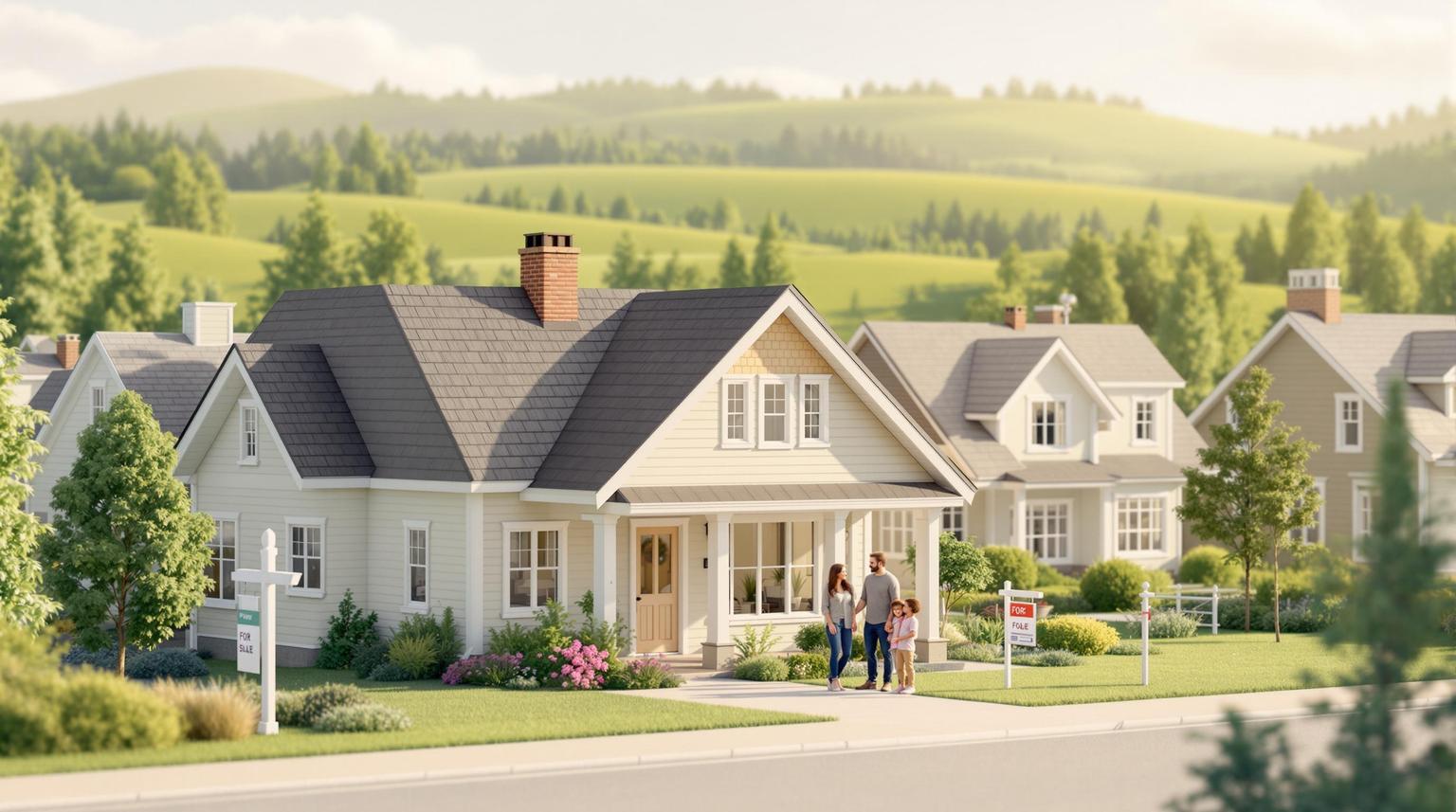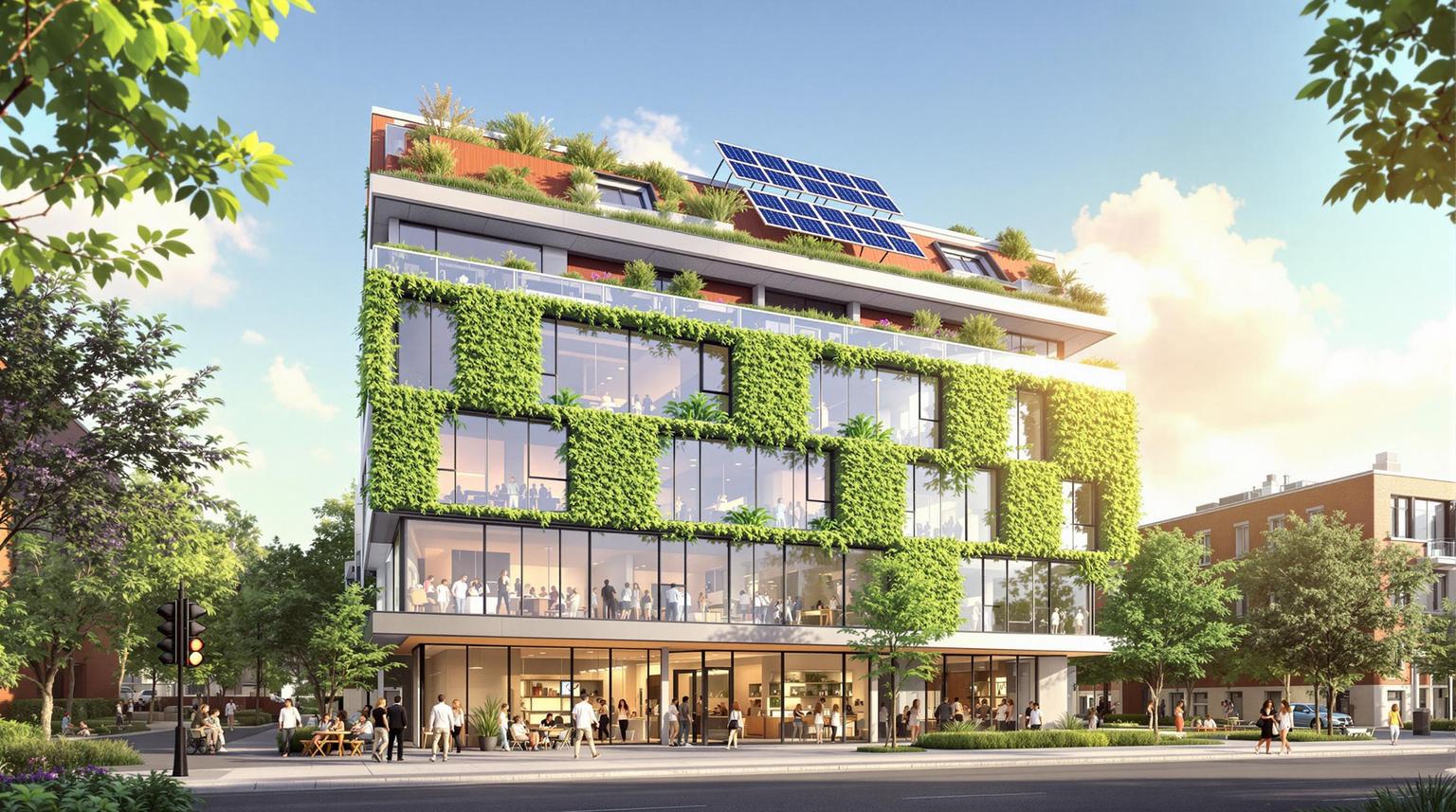Halifax's ER3 zoning, introduced in 2021 under the Centre Plan's Package B, allows for the development of multi-unit residential buildings (up to 8 units) in established neighbourhoods. It aims to address the city's housing demand by enabling medium-density projects along transit routes and urban hubs. Key features include:
- Height Limit: 12 metres (3-4 storeys).
- Lot Coverage: Up to 60% for smaller lots, 50% for larger ones.
- Parking Requirements: None for new builds in the Regional Centre.
- Approval Process: Simplified for proposals meeting zoning criteria (as-of-right); discretionary reviews for exceptions.
- Design Standards: Street-facing entrances, fenestration requirements, and garbage screening for larger properties.
ER3 zoning supports Halifax's goal of increasing the Regional Centre's housing share to 40% of municipal growth. It provides opportunities for investors to build rental properties while addressing the city's housing shortage. Early successes show strong rental demand, with two-bedroom units renting for $1,950–$2,100/month and annual returns of 12–20%.
Pro Tip: Use integrated design-build methods to reduce delays, avoid redesign costs, and simplify compliance with zoning rules.
How to Quickly Look Up Zoning in Halifax, Nova Scotia
What ER3 Zoning Allows
ER3 zoning offers property owners in Halifax a range of possibilities for developing multi-unit rental properties. It simplifies decision-making for investors and developers by providing clear guidelines.
Buildings Allowed Under ER3
ER3 zoning supports a variety of multi-unit housing options, bridging the gap between single-family homes and large apartment buildings. Property owners can construct buildings with up to 8 units on a single lot, making it one of Halifax's most adaptable residential zoning categories [1][2].
Permitted structures include duplexes, townhomes, small apartment buildings, and condos, with unit counts ranging from 2 to 8, depending on the lot's size and layout. This variety allows property owners to choose a building type that aligns with their budget, lot dimensions, and development goals.
This zoning category plays a crucial role in Halifax's rental market by offering medium-density housing options, addressing the shortage of alternatives between single-family homes and high-rise developments [2][3].
These building options set the foundation for understanding the design standards tied to ER3 zoning.
Design and Building Standards
ER3 zoning includes specific design guidelines to ensure that new developments fit within the neighbourhood's character while offering flexibility for builders. For instance, buildings can be up to 12 metres tall, accommodating three to four storeys [1][2].
Lot coverage rules depend on the property size. For lots larger than 3,500 square feet, multi-unit buildings can cover up to 50% of the lot. Smaller lots, under 3,500 square feet, are allowed up to 60% coverage [1]. These rules help balance green space, drainage, and efficient land use.
Additionally, ER3 zoning removes minimum parking requirements for new builds within the regional centre [2].
With these standards in place, the number of units allowed is determined by the lot's characteristics.
Unit Limits
ER3 zoning also specifies the maximum number of units per lot. While the zoning allows up to 8 units, the actual number depends on factors like lot size, configuration, and adherence to building standards.
In February 2024, Halifax municipal staff proposed expanding ER3 zones as part of a broader plan to create 15,000 new housing units over three years, supported by the federal Housing Accelerator Fund. This initiative highlights the role of ER3 zoning in addressing Halifax's housing needs [1].
Getting Approval for ER3 Projects
Understanding Halifax's ER3 approval process is key to avoiding delays and unexpected costs. The Centre Plan is designed to simplify approvals, but it's essential to determine whether your project qualifies for as-of-right approval or requires a discretionary review.
As‐of‐Right vs Discretionary Approvals
For most multi-unit projects, ER3 zoning allows for as-of-right approvals, provided the proposal meets zoning criteria like height limits, lot coverage, and setbacks. These projects can usually move forward with a straightforward building permit application. However, if your plans involve variances or don't meet standard requirements, they’ll need to go through a discretionary review. This process can add time and expenses to your project. Additional assessments, such as a site plan review, might also be required. Ensuring your project complies with all guidelines from the start is critical.
Meeting Compliance Requirements
Adhering to Halifax's municipal and zoning guidelines is essential to keep your project on track and avoid unnecessary delays.
Common Approval Mistakes to Avoid
One common mistake is skipping thorough due diligence before purchasing property. This oversight can lead to unexpected zoning restrictions or site conditions that complicate development[4]. Another frequent issue is submitting incomplete or inaccurate applications, which can significantly delay the approval process. Collaborating with experienced professionals familiar with Halifax's ER3 zoning requirements can help you navigate these challenges effectively.
Investment Opportunities with ER3 Zoning
Halifax's ER3 zoning opens up exciting possibilities for property owners looking to develop multi-unit rental properties. Thanks to the Centre Plan, higher-density projects are now more feasible, addressing the city's growing need for rental housing.
Tackling Halifax's Rental Housing Shortage
ER3 zoning plays a key role in alleviating Halifax's rental housing crunch by encouraging missing middle housing - the type that bridges the gap between single-family homes and high-rise apartments [2]. For investors, this zoning allows the creation of multiple units on a single property, maximizing its potential while boosting the city's rental supply.
Take two-bedroom units as an example: these are in high demand, with rental rates typically ranging between $1,950 and $2,100 per month. This kind of development not only increases housing options but also positions investors for strong rental yields.
Boosting Returns with Multi-Unit Projects
Multi-unit developments under ER3 zoning offer a clear financial edge over single-family rentals. By consolidating several units on one lot, investors can enjoy higher rental income per square foot, lower construction and maintenance costs due to economies of scale, and better financing options. Projects with four or more units often achieve annual returns between 12–20%.
The zoning also allows for cost-efficient construction. Buildings can reach heights of 11–12 metres, with an additional 3-metre allowance for pitched roofs or attics [2][5]. Plus, there's no minimum parking requirement for residential developments in regional centres and suburbs [2][5], leaving more space for additional units and boosting overall profitability.
Early Success Stories with ER3 Projects
Although ER3 zoning is relatively new, early projects highlight its potential. Property owners are successfully constructing fourplexes, sixplexes, and small apartment buildings that meet design standards and align with neighbourhood aesthetics.
These developments often feature smart layouts, street-facing entrances, and sufficient window space, all while adhering to bedroom limits to avoid overcrowding [5]. By focusing on efficient design, these projects not only blend seamlessly into their surroundings but also streamline construction timelines.
For instance, using an integrated design-build approach, some projects are being completed in just six months, with construction costs averaging $160,000 per unit.
The early results show that ER3 zoning enables property owners to achieve solid financial returns while playing a meaningful role in addressing Halifax's urgent rental housing needs.
sbb-itb-16b8a48
Integrated Design-Build for ER3 Projects
When it comes to tackling the challenges of ER3 zoning, particularly in approvals and design, property owners often face a minefield of construction hurdles. An integrated design-build model can help smooth out these issues. Building multi-unit rental properties under Halifax's ER3 zoning typically involves juggling numerous professionals, managing budgets that spiral out of control, and dealing with drawn-out timelines. The integrated design-build approach simplifies this process by addressing the inefficiencies of traditional, fragmented construction methods.
Fragmented vs. Integrated Construction Methods
In traditional construction, property owners hire separate professionals for each phase - architects, engineers, contractors, and trades. This fragmented setup often leads to miscommunication, delays, and cost overruns, which can range from 30-60% above initial budgets. Halifax's ER3 zoning adds another layer of complexity with requirements like maximum building dimensions of 20 metres by 30 metres for buildings with five or more units, specific fenestration standards, street-facing entrances, and garbage screening mandates[8]. When these professionals work independently, compliance issues frequently arise during permitting, triggering costly redesigns.
The integrated design-build model takes a different approach. Instead of piecing together separate teams, one company manages both design and construction, creating a single point of responsibility. According to the Design-Build Institute of America, this method delivers projects 102% faster and curbs cost growth by 3.8%, compared to traditional methods.
| Aspect | Fragmented Approach | Integrated Design-Build |
|---|---|---|
| Contracting | Separate designer and contractor; owner coordinates | Single point of responsibility |
| Cost Control | Later in process; higher risk of change orders | Fixed price earlier; fewer changes |
| Schedule | Sequential (design, bid, build) | Overlapping design and construction |
| Coordination | Higher risk of disputes and gaps | Collaborative problem-solving |
| Permitting Response | Frequent redesign cycles | Compliance handled within one team |
| Risk Management | Owner assumes risk for design errors | Design-builder takes on performance risk |
| Best Fit for ER3 | Slower to adapt to zoning rules | Quickly aligns with ER3 requirements |
Benefits of Integrated Design-Build
This approach offers several advantages that directly address the challenges of ER3 projects. For starters, fixed-price contracts become feasible once the design reaches 30-60% completion. This reduces the risk of cost overruns for property owners and simplifies lender underwriting for smaller multifamily developments.
Another major benefit is speed. Integrated teams can overlap design and construction phases, cutting down on overall timelines. Trade partners are actively involved during the design phase, helping to resolve compliance issues like building envelope restrictions and garbage screening before permits are even submitted.
Collaboration also minimizes change orders. By having architects, engineers, and construction teams work together from the outset, ER3 requirements can be incorporated during the concept stage. This avoids the all-too-common scenario of permit comments forcing expensive redesigns months into the project.
Faster project delivery means rental income can start sooner. Plus, streamlined communication reduces the stress of managing multiple contracts and relationships, making the process far more manageable for property owners.
How Helio Urban Development Handles ER3 Projects

Nova Scotia-based Helio Urban Development offers a clear example of how the integrated design-build model works in practice. Specializing in 4+ unit rental properties, the company was founded by Lloyd Liu (a Yale MBA and former Merrill Lynch banker) and Yuan He (a data scientist from the University of Pennsylvania). Their mission? To eliminate the coordination chaos that often plagues multi-unit construction.
Helio’s approach revolves around early compliance checks. They require an ER3 compliance matrix at every design milestone and won’t submit for permits without it[6][7]. This proactive strategy prevents zoning conflicts from derailing projects during the approval process.
The company offers fixed-price construction at $160,000 per unit with a 6-month completion guarantee. If delays occur, they pay penalties of up to $1,000 per day - a level of accountability made possible by their integrated model, which avoids the blame-shifting common in fragmented setups.
Currently, Helio has 31 units under construction and 131 more in planning across Nova Scotia. Their scheduling system ensures projects stay on track, reducing typical 8-month timelines to just 6 months. For ER3 projects, they secure long-lead items as soon as contracts are awarded and set service-level agreements for permit responses and RFIs. Progress is tracked in a shared log aligned with Halifax Regional Municipality timelines[7].
Helio’s systematic approach allows property owners to focus on their investment strategies rather than getting bogged down in construction details. With daily photo updates and clear communication, owners can monitor progress without the headache of managing day-to-day operations.
This integrated model is particularly effective for ER3 projects, as it adapts quickly to Halifax’s zoning requirements while delivering cost and schedule certainty - exactly what’s needed to make these investments financially viable.
Conclusion: Making the Most of ER3 Zoning
Halifax's ER3 zoning offers a promising avenue for developing multi-unit rental projects while addressing the city's growing housing needs. Introduced in 2021, this zoning designation simplifies the approval process for small multi-unit buildings, especially along transit corridors and high-traffic streets.
Some standout features include the elimination of parking requirements, an 11-metre height limit (with an additional 3 metres for pitched roofs), and fixed building dimensions (20m x 30m for projects with five or more units). These measures ensure new developments fit seamlessly into existing neighbourhoods while streamlining construction approvals[8].
Starting any ER3 project with compliance in mind is crucial to avoid costly redesigns and delays. Key requirements - like street-facing entrances, minimum fenestration standards, and proper garbage screening for buildings with four or more units - help ensure a smooth approval process. Additionally, upcoming updates to Halifax's Centre Plan are expected to expand ER3 zoning, replacing many ER-1 and ER-2 areas and allowing up to 60% lot coverage on larger properties. These changes could unlock even more opportunities for multi-unit infill developments across the Regional Centre[8][9].
The financial potential of ER3 projects is undeniable. With two-bedroom units renting for $1,950–2,100 per month, property owners can achieve annual returns ranging from 12–20%. Adopting an integrated design-build approach further mitigates risks, reducing the likelihood of cost overruns (by 30–60%) and delays.
Helio Urban Development serves as a prime example of how to succeed with ER3 zoning. Their approach combines fixed-price construction - at $160,000 per unit - with a 6-month completion guarantee. With 31 units under construction and plans for 131 more across Nova Scotia, their results highlight the benefits of a unified design and construction strategy[6][7].
Ultimately, the key to success lies in understanding ER3 guidelines, planning for compliance from the outset, and avoiding fragmented construction practices. In a housing market where demand continues to outstrip supply, ER3 zoning offers not just a profitable business opportunity but also a meaningful way to contribute to Halifax's housing challenges.
FAQs
What are the advantages of using a design-build approach for ER3 zoning projects in Halifax?
Using a design-build approach for ER3 zoning projects in Halifax comes with some clear advantages. By merging the design and construction phases into one seamless process, this method helps save time and keeps costs more predictable. In fact, multi-unit developments can often be completed in as little as six months, allowing property owners to get their projects to market much faster.
The integration of design and construction teams also reduces the chances of delays, keeps budgets on track, and ensures smooth communication throughout every stage. For property owners tackling the challenges of ER3 zoning, this approach offers an efficient way to navigate the process while making the most of Halifax’s expanding rental market.
How does ER3 zoning help address Halifax’s housing needs and create opportunities for property investors?
ER3 Zoning and Halifax's Housing Needs
ER3 zoning is a vital tool in addressing Halifax's housing challenges. By permitting the construction of residential buildings with up to eight units on a single lot, this zoning creates opportunities for higher-density housing. Think small multi-unit buildings, townhouses, or even backyard suites - options that not only help ease the housing shortage but also provide residents with more varied rental choices.
For property investors, ER3 zoning is a game-changer. It allows for the development of up to eight units per lot, offering the chance to tap into Halifax’s expanding rental market. This means more potential for rental income while playing a part in meeting the city’s demand for affordable and accessible housing.
What are the main requirements for ER3 zoning in Halifax, and how can property owners streamline the approval process?
Navigating Halifax's ER3 Zoning Rules
If you're planning a project in Halifax's ER3 zoning area, there are some key rules you need to follow. For starters, buildings can't exceed a maximum height of 11 metres. You'll also need to adhere to specific setback requirements and ensure your lot meets the minimum size of 325 m² with a frontage of at least 10.7 metres. On the bright side, recent changes have removed minimum parking requirements, making the approval process a bit less complicated.
To keep things moving smoothly, it's a good idea to prepare detailed site plans that clearly show how your project aligns with these zoning regulations. Another smart move? Connect with municipal planning staff early in the process. This gives you the chance to address any questions or issues upfront, helping to avoid unnecessary delays and making the approval journey much easier.



